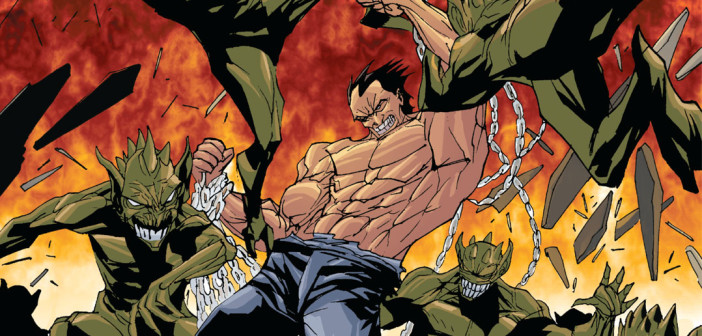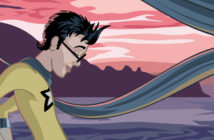The third installment of Jamie Gambell and J.C. Grande’s gothic miniseries, Omnitarium, pulled me in many directions as I read it. Admittedly, I had a hard time keeping up with the unfolding plot, but I great admired the energy and atmospherics that framed the overall story, accented by artist Grande’s stark black-and-white illustrations.
For anyone who hasn’t been keeping up with Omnitarium, this is no place to jump in; follow the links to read my reviews of issues one and two. Here in the third and penultimate issue, sheer chaos has broken out in the Pentansly Gaol, a brooding Victorian prison and asylum. The series up until this point has focused on the return of an evil sorcerer who first appeared in a flashback at the very beginning of the series, which poses a bit of a problem for writer Gambell’s story.
Since the beginning, I worried that the miniseries aspect of Omnitarium would hinder the narrative complexity that Gambell is going for. He seems to be drawing inspiration from gothic works like Horace Walpole’s The Castle of Otranto, Matthew Lewis’ The Monk, and Ann Radcliffe’s The Mysteries of Udolpho. I’m fascinated by gothic literature and storytelling: it requires a delicate balance of literary horror, romance, drama, and suspense. Above all else, it’s woven together with powerful atmospherics.
The miniseries format simply isn’t broad enough for Gambell to touch upon all of the fine details needed in this kind of brooding story. He begins them, yes, by introducing a cast of aristocratic characters, all locked away in a menacing manor where terrors unfold—a common prerequisite for the genre. But Gambell attempts to do too much in too small a space.
I don’t fault him for this, however. If anything, I admire his tenacity: he has a story he wants to tell, and he’s willing to work with what he currently has. It’s no trade secret that while independent comics are somewhat easy to make, they still largely require autonomous funding. I’m sure Gambell doesn’t have an unlimited budget, so a miniseries is probably all he has to work with at the moment. It’s unfair to fault him for that.
But where the story is confused at times, the atmospherics work, and work well. I had a hard time with Grande’s artwork in the past, but not because he’s an untalented artist. I recently looked at some other examples of his work, and he’s quite the opposite; the scope and breadth of styles he’s able to adapt to are no small feat. I’m not so sure that black-and-while illustrations suit his abilities overall, but in this issue he uses heavy shadows in the environment, creating a spooky aura.
The third installment of Omnitarium is largely silent; we’re following along with Gambell’s direction and Grande images, and because of that this issue is my favorite thus far. It’s much more of an experience than the first two. At times, I felt like I was running through the halls of the Pentansly Gaol as well, but when considering my threshold of stamina, it’s a good thing I was not.
This comic book review originally appeared on Broken Frontier.




